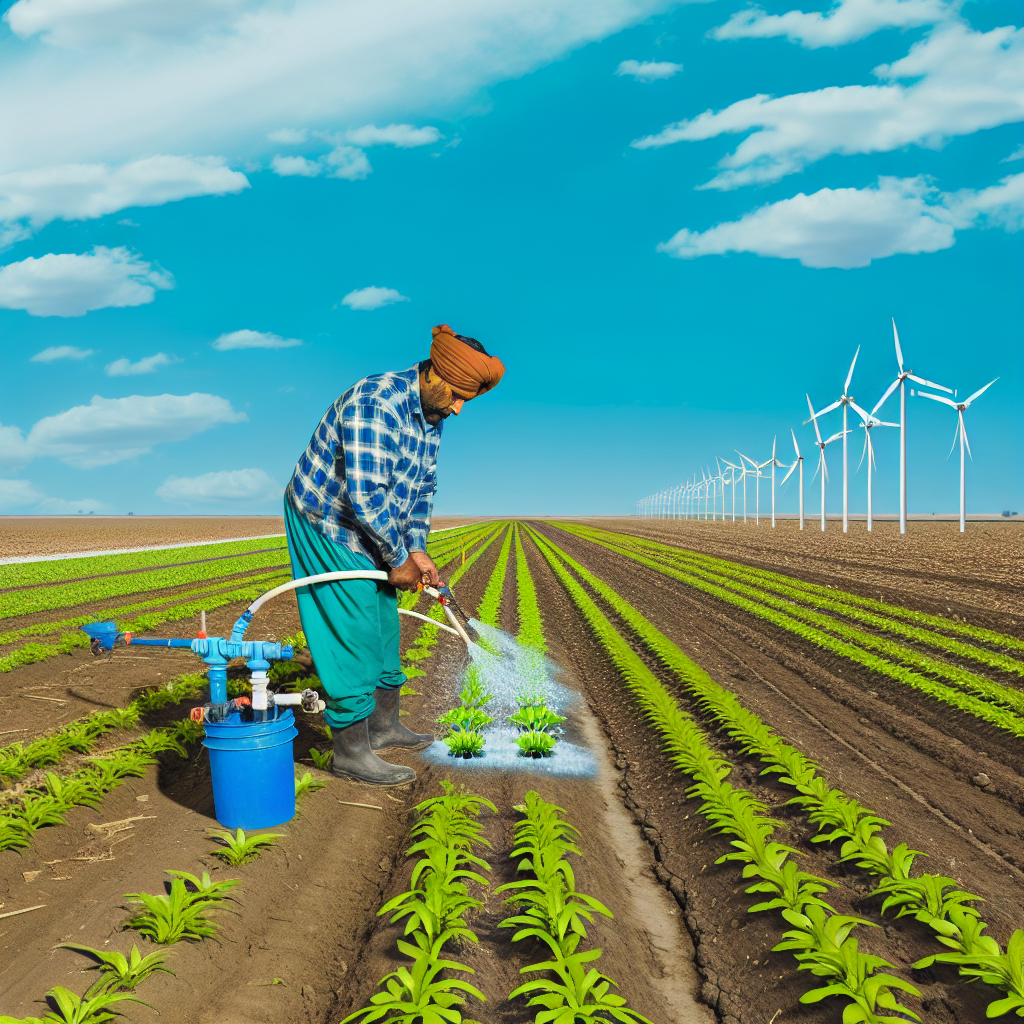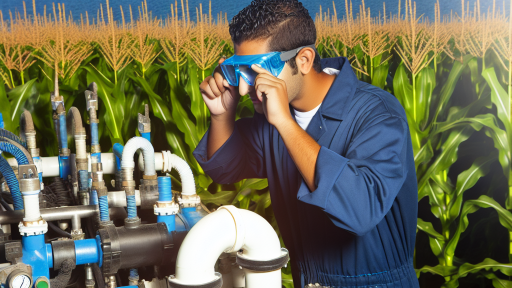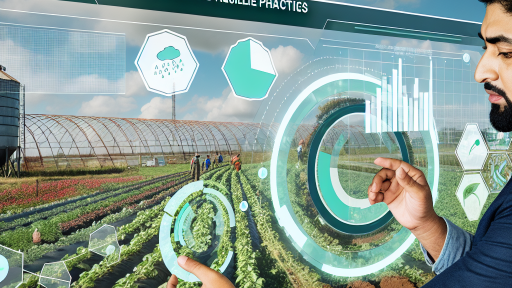Introduction to Climate-Smart Farming
Climate-smart farming focuses on sustainable agricultural practices.
It aims to increase productivity while reducing environmental impact.
This approach is vital as climate change affects food systems globally.
Farmers face many challenges, including extreme weather and resource scarcity.
Therefore, adapting farming methods is essential for resilience.
Definition of Climate-Smart Farming
Climate-smart farming incorporates techniques that enhance resource efficiency.
It emphasizes the use of renewable resources in agricultural production.
This method integrates sustainable practices to reduce greenhouse gas emissions.
Moreover, it focuses on adapting to changing climate conditions.
Ultimately, this approach supports food security and rural development.
Importance of Climate-Smart Farming
Climate-smart farming is crucial for addressing global food demand.
As populations grow, food production must increase without harming the environment.
This approach enhances the resilience of ecosystems and communities.
Additionally, it promotes biodiversity and soil health.
Farmers can achieve better yields through effective climate adaptation strategies.
Transform Your Agribusiness
Unlock your farm's potential with expert advice tailored to your needs. Get actionable steps that drive real results.
Get StartedOverall, climate-smart agriculture contributes significantly to sustainability.
Key Principles of Climate-Smart Agriculture
Enhancing Resilience
Climate-smart agriculture enhances resilience to climate change.
Farmers adopt diverse cropping systems to protect against climate impacts.
This diversity improves soil health and promotes biodiversity.
Increasing Productivity
Productivity remains a central goal of climate-smart practices.
Farmers focus on sustainable intensification of production systems.
They utilize improved seeds and efficient irrigation techniques.
Additionally, integrated pest management minimizes losses without harming the environment.
Reducing Greenhouse Gas Emissions
Reducing greenhouse gas (GHG) emissions is vital for climate-smart agriculture.
Farmers implement practices like no-till and cover cropping.
These methods enhance carbon sequestration in the soil.
Moreover, optimizing fertilizer use minimizes nitrous oxide emissions.
Promoting Sustainable Practices
Climate-smart agriculture promotes sustainability across farming systems.
It encourages the use of renewable energy sources in operations.
Farmers also adopt agroforestry, which combines crops with tree planting.
This approach provides shade, improves soil quality, and sequesters carbon.
Engaging Communities
Community engagement plays a crucial role in climate-smart agriculture.
Farmers collaborate with local organizations to share knowledge.
This collaboration helps promote best practices and innovations.
Furthermore, communities work together to implement local adaptation strategies.
Utilizing Data and Technology
Data-driven decision-making enhances the effectiveness of climate-smart agriculture.
Farmers utilize precision agriculture technologies to optimize inputs.
This includes using sensors, drones, and satellite imagery.
Such technologies improve efficiency and reduce waste in farming practices.
Showcase Your Farming Business
Publish your professional farming services profile on our blog for a one-time fee of $200 and reach a dedicated audience of farmers and agribusiness owners.
Publish Your ProfileAdapting Crop Selection to Changing Climate Conditions
The Importance of Crop Diversity
Diverse crops enhance resilience against climate fluctuations.
This variety minimizes risks associated with pest infestations.
Additionally, it supports soil health and improves overall yields.
Evaluating Local Climate Trends
Farmers must analyze local climate data regularly.
This analysis reveals patterns that indicate shifting weather conditions.
Consequently, understanding these trends guides crop selection decisions.
Identifying Climate-Resilient Crops
Climate-resilient crops withstand extreme weather better.
They require less water and can endure drought conditions.
Furthermore, they can thrive in varying temperatures and soil types.
Experimenting with New Varieties
Farmers should consider introducing new crop varieties gradually.
This experimentation allows for assessing performance under local conditions.
Choosing genetically modified organisms (GMOs) can also provide benefits.
Engaging with Agricultural Research Institutions
Collaborating with local agricultural research institutions enhances success.
These institutions often provide resources and data on crop performance.
Additionally, they share insights on best practices for climate-smart farming.
Utilizing Technology for Climate Adaptation
Technology plays a vital role in adapting crop selection.
Farmers can use climate modeling tools to predict future conditions.
Precision agriculture technologies help in monitoring crop health.
Sharing Knowledge within the Farming Community
Farmers should actively share experiences and strategies.
This collaboration fosters community resilience among local farmers.
Workshops and meetings can facilitate valuable exchanges of information.
Discover More: Renewable Energy Adoption in Sustainable Farming
Innovative Soil Management Techniques for Resilience
Understanding Soil Health
Healthy soil is the foundation of resilient farming.
It supports crop growth and enhances biodiversity.
Moreover, healthy soil improves water retention and drainage.
Farmers must regularly test soil to assess its health.
Implementing Cover Cropping
Cover cropping involves planting specific crops during off-seasons.
This practice protects the soil from erosion and compaction.
Furthermore, it enhances soil organic matter and nutrients.
- Common cover crops include clover, rye, and vetch.
- They attract beneficial insects and pollinators.
- Moreover, they suppress weeds naturally.
Practicing No-Till Farming
No-till farming minimizes soil disturbance.
This technique helps maintain soil structure and health.
Additionally, it reduces erosion and increases water infiltration.
Farmers can implement cover crops in a no-till system.
Utilizing Crop Rotation
Crop rotation enhances soil fertility and health.
This method involves alternating different crops in a sequence.
It disrupts pest and disease cycles effectively.
Also, rotating crops can improve nutrient balance in the soil.
- Legumes can fix nitrogen, benefiting subsequent crops.
- Root crops enhance soil structure and aeration.
Adopting Agroforestry Practices
Agroforestry integrates trees and shrubs with crops and livestock.
This method contributes to enhanced soil stability.
Additionally, it increases biodiversity on farms.
Showcase Your Farming Business
Publish your professional farming services profile on our blog for a one-time fee of $200 and reach a dedicated audience of farmers and agribusiness owners.
Publish Your ProfilePlants work together to improve nutrient cycling and water efficiency.
Employing Organic Amendments
Organic amendments improve soil structure and fertility.
Examples include compost, manure, and biochar.
These materials enhance microbial activity in the soil.
Consequently, they promote nutrient availability for crops.
Enhancing Water Retention Techniques
Water retention is crucial for sustainable agriculture.
Practices like mulching can significantly improve moisture levels.
Additionally, contour farming can reduce runoff and erosion.
- Implementing rainwater harvesting systems is beneficial.
- Incorporating swales can direct water to where it’s needed.
Integrating Technology in Soil Management
Modern technology offers tools for better soil management.
Farmers can use sensors to monitor soil moisture and nutrients.
Furthermore, precision agriculture optimizes inputs and minimizes waste.
Remote sensing can provide valuable data about soil conditions.
See Related Content: Renewable Energy Options for Climate-Smart Farms
Water Conservation Strategies in Climate-Smart Farming
Understanding Water Conservation
Water conservation is crucial for sustainable agriculture.
Farmers face increasing challenges due to climate change.
Adopting effective strategies can drastically mitigate water shortages.
Implementing Efficient Irrigation Systems
Modern irrigation techniques enhance water efficiency.
Drip irrigation delivers precise amounts to plants.
This method reduces water wastage significantly.
Sprinkler systems can cover large areas evenly.
Using moisture sensors helps in timely watering.
Harvesting Rainwater
Collecting rainwater is an excellent conservation method.
Farmers can set up rain barrels or cisterns.
These systems store water for dry periods.
Rainwater is often free from harmful chemicals.
Soil Health Improvement
Healthy soil retains moisture more effectively.
Practicing no-till farming enhances soil structure.
Cover crops protect soil and prevent erosion.
Composting organic matter enriches soil quality.
Crop Selection and Rotation
Choosing drought-resistant crops can save water.
Rotating crops maintains soil fertility and moisture.
Diverse planting reduces pest pressure as well.
Education and Community Practices
Farmers benefit from educational programs on conservation.
Networking with local farmers fosters knowledge sharing.
Community initiatives can support water-saving techniques.
Monitoring and Adapting Practices
Regularly monitoring water usage helps optimize practices.
Farmers can adjust strategies based on weather patterns.
Using technology, such as apps, assists in tracking usage.
Continuous learning and adaptation lead to long-term success.
Find Out More: Solar-Powered Irrigation Systems for Efficient Water Use
Showcase Your Farming Business
Publish your professional farming services profile on our blog for a one-time fee of $200 and reach a dedicated audience of farmers and agribusiness owners.
Publish Your ProfileIntegrating Agroforestry Practices for Enhanced Biodiversity
Defining Agroforestry
Agroforestry combines agriculture and forestry practices effectively.
This integration builds a more sustainable agricultural system.
It enhances biodiversity and improves soil health.
Benefits of Agroforestry
Agroforestry provides numerous ecological benefits.
It increases habitat availability for various species.
Moreover, it enhances pollination services critical for crops.
This practice also improves soil structure and fertility.
Additionally, it helps in carbon sequestration efforts.
Implementing Agroforestry Techniques
Farmers can adopt several agroforestry techniques readily.
Alley cropping is one effective method.
This involves planting crops between rows of trees.
Benefits of Alley Cropping
Alley cropping improves light penetration and moisture retention.
It minimizes soil erosion by providing ground cover.
Silvopasture as a Sustainable Option
Silvopasture integrates trees, forage, and livestock.
This approach optimizes land use and productivity.
It reduces heat stress for grazing animals.
Key Advantages of Silvopasture
By integrating trees, farms can improve biodiversity.
It also enhances nutrient cycling within the ecosystem.
Promotion of Local Species
Utilizing native trees and plants is crucial.
This supports local wildlife and preserves genetic diversity.
Incorporating local species leads to a resilient ecosystem.
Community-Based Initiatives
Collaboration among farmers strengthens agroforestry practices.
Local knowledge sharing is vital for success.
Community-driven projects can lead to sustainable practices.
Monitoring and Adapting Practices
Continuous monitoring is essential for success.
Farmers should adjust practices based on ecosystem feedback.
This adaptation ensures the resilience of agroforestry systems.
Gain More Insights: Transitioning to Renewable Energy in Agriculture

Utilizing Technology and Data for Climate Adaptation
The Role of Technology in Modern Farming
Technology drives significant changes in agricultural practices.
Farmers now use advanced tools to enhance productivity.
For instance, drones monitor crop health effectively.
Moreover, precision farming techniques increase resource efficiency.
Some farms use GPS technology for accurate planting.
This approach minimizes waste and maximizes yield.
Data-Driven Decision Making
Data plays a crucial role in climate-smart farming.
Farmers leverage data analytics to make informed decisions.
This information helps predict weather patterns accurately.
Consequently, farmers can adjust planting schedules accordingly.
Additionally, historical data provides insights into crop performance.
This enables better planning for future cropping seasons.
Showcase Your Farming Business
Publish your professional farming services profile on our blog for a one-time fee of $200 and reach a dedicated audience of farmers and agribusiness owners.
Publish Your ProfileClimate Modeling Tools
Climate modeling tools assist farmers in understanding future scenarios.
These models simulate weather conditions for specific regions.
As a result, farmers can prepare for potential challenges.
They can also identify suitable crop varieties for changing climates.
Adopting Smart Irrigation Techniques
Smart irrigation systems optimize water use efficiently.
These systems utilize sensors to monitor soil moisture levels.
This ensures crops receive the right amount of water.
Subsequently, farmers conserve water resources effectively.
Furthermore, these practices reduce operating costs.
Integrating Renewable Energy Sources
Many farmers are adopting renewable energy technologies.
Solar panels and wind turbines provide sustainable energy options.
Transitioning to renewable energy reduces dependence on fossil fuels.
In addition, it lowers greenhouse gas emissions significantly.
Collaboration and Knowledge Sharing
Farmers benefit from collaborating with researchers and tech companies.
Such partnerships foster innovation and shared knowledge.
Workshops and seminars help disseminate best practices widely.
Participating in local farming networks enriches community learning.
This collective approach enhances resilience among farmers.
Policies and Support Systems for Climate-Smart Farmers
Government Incentives
Government programs play a crucial role in promoting climate-smart farming.
These initiatives often provide financial assistance to farmers adopting sustainable practices.
Such incentives can include grants, low-interest loans, and tax rebates.
Additionally, governments may offer subsidies for climate-smart technologies.
Consequently, these financial supports encourage farmers to innovate and adapt.
Research and Development Support
Investment in research and development is vital for climate-smart initiatives.
Universities and agricultural organizations collaborate to discover new practices.
These collaborations help farmers access the latest advancements in sustainable agriculture.
Moreover, research efforts focus on developing climate-resilient crop varieties.
This ensures that farmers can withstand extreme weather conditions and pests.
Education and Training Programs
Education and training are essential for successful climate-smart implementation.
Farmers must understand the techniques and technologies available to them.
Extension services provide workshops and seminars to share knowledge effectively.
Furthermore, online courses and resources enhance learning opportunities for farmers.
As a result, this education empowers farmers to make informed decisions.
Community Support Networks
Building strong community networks fosters collaboration among farmers.
Local organizations can create support systems for sharing insights and resources.
Networking events, such as farmer markets and cooperative meetings, enhance connection.
These interactions facilitate the exchange of best practices and moral support.
In turn, this builds resilience among farmers facing climate challenges.
Policy Advocacy
Advocacy is necessary to influence policies that support climate-smart farming.
Farmers and agricultural organizations must engage with policymakers effectively.
Showcase Your Farming Business
Publish your professional farming services profile on our blog for a one-time fee of $200 and reach a dedicated audience of farmers and agribusiness owners.
Publish Your ProfileCollaborative efforts can lead to more significant funding and resources for farmers.
Advocacy initiatives raise awareness about the importance of sustainable practices.
These actions ensure that the voices of farmers are heard in the legislative process.
Case Studies: Successful Implementations of Climate-Smart Practices
Innovative Crop Rotation Techniques
Farmers in Iowa have adopted innovative crop rotation techniques.
This method enhances soil health and reduces pest infestations.
As a result, crop yields have improved significantly.
These farmers report increased resilience against climate variability.
Agroforestry in Action
A successful case in Brazil illustrates the power of agroforestry.
Farmers integrated native trees into their cropping systems.
This practice increased biodiversity and improved soil structure.
Moreover, it provided additional income through timber and fruit sales.
Water Management Solutions
In California, farmers implemented advanced water management practices.
They utilized drip irrigation systems for optimal water use.
Consequently, water use decreased while crop yields increased.
This approach effectively addresses water scarcity challenges.
Cover Crops Enhancing Soil Quality
Farmers in Nebraska introduced cover crops during fallow periods.
This method enhances soil health and prevents erosion.
Additionally, it helps maintain moisture levels in the soil.
Farmers report better harvests and reduced fertilizer costs.
Community-Based Adaptation Strategies
A collective initiative in Kenya showcases community-based adaptation.
Farmers shared knowledge on climate-resilient practices.
This collaboration empowered them to adapt effectively to changing conditions.
Furthermore, it built a strong network for support and resource sharing.
Additional Resources
Developing local adaptation strategies for climate change in …
Climate Change Impacts on Agriculture and Food Supply | US EPA




